
|
|
|
|
 |
|
Home Site Search Contact Us Subscribe
|
|
|
|
Sex and the City Part 1: Field Notes from the 10th Venice Architecture Biennale
Libidos on fire in Venice: Urbanism may not be sexy, but our lives may depend on it. By Margaret Helfand, FAIA September 12, 2006 Part 2: A new definition of architectural “fitness.”
On its 10th anniversary, the Venice Architecture Biennale, which opened September 10 and runs through November 19, has finally grown up. Following its birth in 1975, the Biennale spent most of its youth frolicking in the verdant pasture of design for design’s sake. But this year’s offering, “Città, Architettura e Società (Cities, Architecture and Society),” acknowledges the power and influence accorded this bi-annual media extravaganza and, for the first time, the Biennale has committed – with gusto and élan – to addressing the changing global context of rampant urbanization which challenges the very survival of our civilization.
This sprawling exhibition is a full-frontal exposure of the messy problems bedeviling cities around the globe and an implicit call-to-arms for architecture’s support in this life-or-death struggle. The message is illustrated by plenty of data and a handful of typical urban intervention projects in each city pointing to this as a watershed moment in the evolution of life on our planet. To survive – and thrive – in this urban future, we need to ensure the continuation of our species by lusting after the good (strength of the public realm, education, health care, security, mobility, culture, and democracy), and eschewing the bad (crime, depletion of resources, short-sighted thinking, and denigration of the environment that nurtures us). Just as sex has traditionally been our instinctive response for self-preservation on the individual level, intelligent planning and design of the urban global web that now connects us all is the visceral and intuitive drive that will be just as critical to our survival as a species in this new world. And, just as architects were beginning to despair at our lack of influence on the evolution of our planet in a positive direction when the world is in such a mess, we have been invested with a new and powerful libido.
The Arsenale Curated by Richard Burdett
This message comes none too soon. Last month, the U.N. confirmed that, for the first time, over 50% of the world’s population is living in cities. In 1900, only about 10% lived in cities, but by 2050 (or possibly sooner), that figure will be 75% and on its way upwards. The Biennale has a long tradition of bringing star power to deliver its chosen message and this year was no exception. Richard (“Ricky”) Burdett, the global rock star of urbanism, has delivered on that promise as director of this landmark exhibition. Burdett’s credentials are impressive both in the academy and on the ground. He is Centennial Professor in Architecture and Urbanism at the London School of Economics (LSE), serves as advisor to the mayors of London and Barcelona on urban design issues, is architectural adviser to the Tate and the BBC, and is director of the LSE Cities Program’s influential Urban Age project. His Biennale, designed by Aldo Cibic and Luigi Marchetti of Milan-based Cibic&Partners, explores the interaction between cities, architecture, and people through a dramatic collage of statistics, photography, film, video, and mixed-media installations.
Many questions are asked, but he relies on our intelligence and libido to design the path forward. It is no accident that Burdett’s cues are unforgettable. The centerpiece of his argument is an ambitious installation in the 300-meter Corderie building in the Arsenale. Here he profiles the DNA of 16 world cities on four continents (Barcelona, Berlin, Bogotá, Cairo, Caracas, Istanbul, Johannesburg, London, Los Angeles, Mexico City, Milano-Torino, Mumbai, New York, Sao Paulo, Shanghai, and Tokyo). A single room three football fields long and stacked with demographic, economic, and cultural data, along with aerial photographs, maps, diagrams, urban intervention projects, and walk-on video aerial flyovers sounds like a geek’s paradise. But the sheer visceral confrontation with surprising and sometimes scary facts and the palpable passion of Burdett’s message make for a memorable experience. The sensation is somewhere between a call-to-arms and a pulse-quickening biological drive to survive.
Thankfully, Burdett and his designers have a sense of humor in this sea of data. About two football fields through this whirlwind urban world tour – just when you think you might scream if you see another statistic – you arrive in a dark space inhabited by a foursquare grid of towering stalagmites washed with colored lights befitting a nightclub. The instant transition from intellectual to emotional response is bracing. But what is this forest of upthrust? As his pièce de résistance (or some could say climax), he has created a Hall of Density – dramatic, three-dimensional representations of urban density for each of the 16 cities. Who knew that Tokyo, by far the largest city with a population over 38 million, has one of the lower densities? Or that Mumbai has almost twice the maximum density of New York? After absorbing the statistics in the previous city presentations, one can’t avoid feeling these slender towers throb with desire on their upwardly thrusting path. Has urbanization of the planet taken on its own sex drive?
While it is impossible to digest this encyclopedia of an exhibition in its totality, one can graze at particular elements here and there and still get the message. Because each component city produced its own research and exhibition materials, it is inevitable that some are more compelling than others in either content or presentation. One of the most successful cities to present itself is Caracas, arguably one of the cities in the most dire circumstances in the group. With one of the highest percentages of informal (illegal) habitation at over 50%, it has demonstrated one of the most creative strategies for self-improvement. By investing in what they call “petits projets” (an obvious contradistinction to France’s “grand projets” of the 1980s), they have implemented a series of small projects. These infrastructure upgrades, community clinics, schools, and public space projects have created significant improvements in the daily lives of community residents in the city’s squatter communities. It is indeed a visceral experience to be confronted by simple before and after photographs of a dirt path threading up through a hillside barrio that was upgraded to a concrete sidewalk and steps, traversable with dignity in all weather conditions. Another creative high impact/low cost solution is Sao Paulo’s proposal for closing stretches of highway within the urban core to provide recreational space for families and children on weekends and holidays.
Even more compelling are the accompanying statistics sprinkled throughout the exhibition. The statistics show that these modest architectural interventions have a staggering impact on crime reduction, education, health, upward mobility, and a sense of pride in community for these urban residents.
Transportation, as one might expect, is a major thread weaving through the profile of all cities. Burdett is convinced that effective and accessible public transportation is not just a good idea, it has become the essential underpinning of social and economic justice on our planet. Whether it is through the cycle ways built around Bogotá or the new bus routes in Los Angeles, physical access to jobs is the first rung on the ladder toward productive engagement for any individual in any society.
Burdett acknowledges that while urbanism is hardly thought of as a glamorous subject, it may well hold the key to our survival on this planet. “What I’m trying to do is not to diminish the importance of architecture – but to place it in a much wider context. Architectural decisions have deep social implications, and what I have been trying to do is to link the physical with the social.” In his hands the Biennale has become a tool for influencing the development of the discipline. It’s hard not to become infected with his passion for understanding the problems, and accepting that their resolution will be an ongoing task requiring innovative, strategic, and often small and low-tech solutions. He also observes, wisely, that without a governance system in our cities willing to create transparent, participatory decision-making processes and tackle long range thinking, we have little hope. His personal commitment to educating mayors in Europe and elsewhere through his ongoing Urban Age project is testament to the value he places in intelligent, well-informed political leadership. Architects take note: this is a call-to-arms for advocacy and engagement in the political process!
The Italian Pavilion
While the Corderie sets the stage by framing the issues and posing the questions, the Italian Pavilion in the Giardini, also directed and designed by Burdett and his team, is intended to suggest some solutions. He looks to 12 influential research and teaching institutions from Italy, Mexico, India, Germany, Holland, Switzerland, UK, and the US to illustrate the current re-engagement of the architectural profession with social and economic processes. These offerings run the gamut of high tech concepts and gadgetry (folding, stackable communal cars; real-time mapping of transportation demand) from MIT’s SENSEable City Laboratory to the Berlage Institute’s pro-active multi-cultural and multi-media installation/seminar “Projecting the City” discussing different ways of reading and intervening in different urban conditions. Communications technology is also showcased with the first Biennale blog site, “SuperBlog,” a joint production of the Architecture Foundation (London) and Museum of Modern Art (New York), offering photo-diaries, reviews, interviews, audio guides to the national pavilions, downloadable podcasts, and links to sites for the cities represented in the Arsenale.
But in the central gallery of the Italian Pavilion, Burdett, again surprising by switching on the libido, juxtaposes the intellectual intensity of research and technology with an astonishing, inspiring, and sensual array of large-format art photographs curated by C-Photo Magazine. These need no words to make their case for the diversity, complexity, creativity, and humanity of urban culture. Among the most striking images are the imaginary townscape “Heliopolis” by Dionisio Gonzales, a digital collage of architecture-meets-barrio, and the microscopic photographs of ice crystals by Masaru Emoto made from water specimens collected from sources as diverse as the Ganges (most pure structure), New York City (somewhat fuzzy), and Rome’s Fontana di Trevi (amorphous blob). The message is clearly communicated that art and science are essential partners in forging the future of the human condition in our cities.
-- End Part 1 --
Margaret Helfand, FAIA, is founder and principal of New York City-based Helfand Architecture.
Also by the author: Observations from the
Field: Metamorphosis and Transcending Hype
|
(click on pictures to enlarge) 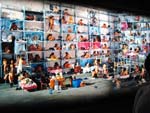 (Jon Turner) Italian Pavilion: Future urban dreamscape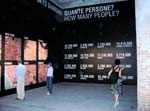 (Jon Turner) Arsenale: Statistical foreplay opens the exhibition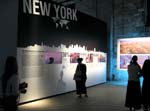 (Jon Turner) Arsenale: New York City quantified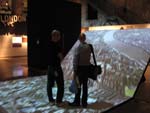 (Jon Turner) Arsenale: Road test for London walk-on video fly-over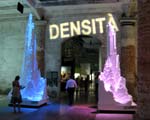 (Jon Turner) Arsenale: Statistically towering cities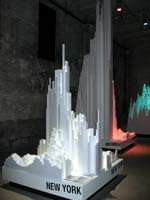 (Jon Turner) Arsenale: Some cities tower less than expected (Jon Turner) Arsenale: Petits Projets in Caracas (Jon Turner) Italian coffee: the natural antidote to data overexposure at the Arsenale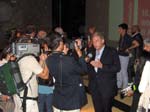 (Jon Turner) Arsenale: Global rock star of urbanism Ricky Burdett at his press conference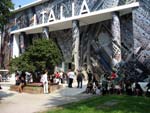 (Jon Turner) The Italian Pavilion shrink wrapped in newly fashionable urban attire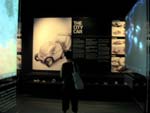 (Jon Turner) Italian Pavilion: MIT’s collapsible City Car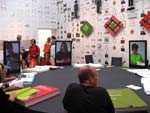 (Jon Turner) Italian Pavilion: Berlage Institute’s multi-cultural video seminar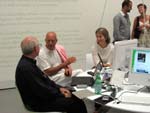 (Jon Turner) Italian Pavilion: Paola Antonelli conducting a live interview with Norman Foster at the “SuperBlog” studio/gallery (Jon Turner) Italian Pavilion: “Heliopolis” (detail), a constructed digital townscape by Dionisio Gonzales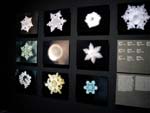 (Jon Turner) Italian Pavilion: Water crystal photomicroscopy by Masaru Emoto |
© 2006 ArchNewsNow.com